Growing okra in containers is not difficult with the right tips. In this article, we include all the tips you will need to grow okra in containers at home this season. Okra (Abelmoschus esculentus), also known as okra, is a plant belonging to the family Malvaceae. It is an annual or biennial plant that grows to a height of 1,6-5 ft (0.5-1.5 m) and is a warm-season plant.
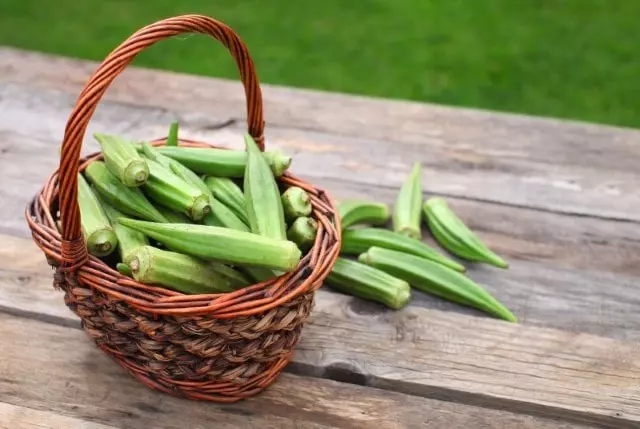
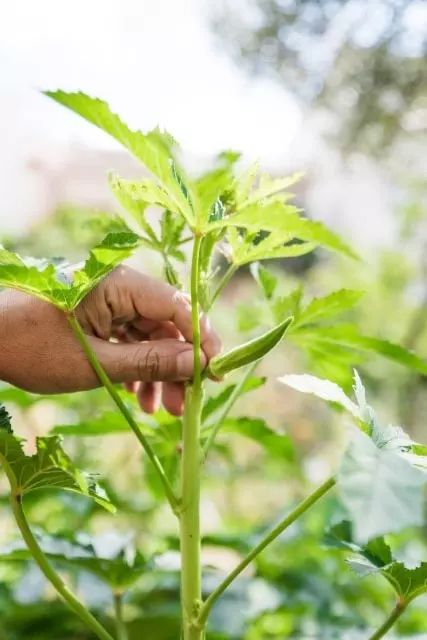
Table of Contents
Varieties of Okra for Containers
Growing okra in containers is a great option for those with limited garden space or those who prefer container gardening. When choosing varieties for containers, it’s essential to consider the size of the container and the growth habits of the okra plant. Here are some okra varieties well-suited for container gardening:
- Clemson Spineless: This is a popular and reliable variety known for its productivity and disease resistance. It has a compact growth habit, making it suitable for containers. Clemson Spineless produces tender, ribbed pods and is well-adapted to various climates.
- Baby Bubba Hybrid: This is a dwarf okra variety specifically bred for container gardening. It reaches a height of about 2 to 3 feet, making it ideal for small spaces. Despite its compact size, it produces flavorful, spineless pods.
- Dwarf Green Long Pod: As the name suggests, this variety has a compact growth habit and is well-suited for container cultivation. It produces slender, green pods and is known for its ability to thrive in confined spaces.
- Annie Oakley II: This is a dwarf okra variety that is perfect for container gardening. It has a bushy growth habit and produces small, spineless pods. Annie Oakley II is a reliable and compact option for limited space.
- Burgundy: If you’re looking for something a bit different, consider the Burgundy okra variety. It has striking red pods and is well-suited for containers. The plant is compact and can add a pop of color to your container garden.
- Harvest in about 50 days
When Is the Best Time to Grow Okra in Containers?
The best time to grow okra in the USA is during the warm months of late spring to early summer. You should plant okra in containers outdoors after the last expected frost date for your region when soil temperatures consistently reach around 65°F (18°C) or higher. Okra thrives in temperatures between 75°F and 90°F (24°C to 32°C) and requires a frost-free growing season, which aligns well with the summer conditions in most parts of the country. Starting okra from seeds indoors a few weeks before the last frost date can also give your plants a head start. Remember that okra loves sunlight, so choose a sunny spot in your garden for optimal growth and productivity.
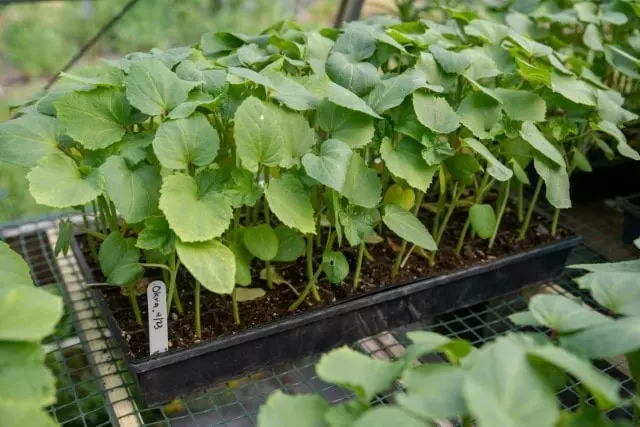
Best Okra Companion Plants Chart
The following plants make excellent companions for okra, enhancing its growth and overall garden health:
- Basil: Known for its pest-repelling properties, basil is a beneficial companion that can deter pests from affecting okra plants.
- Beans and Peas: These legumes contribute nitrogen to the soil, providing a nutrient boost that benefits the neighboring okra plants.
- Cosmos: Beyond their aesthetic appeal, cosmos flowers attract beneficial insects, promoting a healthy and balanced garden ecosystem alongside okra.
- Coneflowers: These native perennials attract pollinators and beneficial insects, fostering a more biodiverse and resilient garden environment.
- Cucumbers: Okra and cucumbers share compatible growth habits, making them mutually beneficial companions in a garden setting.
- Hot Peppers: Like okra, hot peppers prefer warm conditions, and their presence can complement each other, creating a harmonious growing environment.
- Melons: Melons and okra thrive in similar warm and sunny conditions, making them suitable companions for a vibrant and productive garden.
- Oregano: This aromatic herb not only adds flavor to your culinary endeavors but also acts as a natural pest deterrent, benefiting okra plants.
- Radishes: Planting radishes near okra can help repel certain pests while serving as a space-efficient and complementary addition to your garden.
- Zinnias: These colorful flowers not only add visual appeal to your garden but also attract pollinators, contributing to the overall health and productivity of okra plants.
Basil, oregano, coneflowers, and zinnias are the best companion plants when growing okra in containers and are perfect options for a gardener beginner. It’s so easy to grow these two herbs and flowers from seeds. You should try it! Just follow the link to read each growing and caring guide.
By incorporating these companion plants, you can create a well-balanced and harmonious garden environment, promoting the success of your okra crop.
| Companion Plants | Benefits for Okra |
|---|---|
| Basil | Pest repellent |
| Beans and Peas | Nitrogen fixation |
| Cosmos | Attracts beneficial insects |
| Coneflowers | Attract pollinators |
| Cucumbers | Compatible growth |
| Hot Peppers | Similar climate preferences |
| Melons | Similar growing conditions |
| Oregano | Pest deterrent, aromatic |
| Radishes | Pest repellent |
| Zinnias | Attracts pollinators |
How to Grow Okra in Containers
The following paragraphs will look at the general requirements for growing okra. We will also look at tips on how to meet the requirements for growing okra in containers at home as well as growing okra in the ground. We encourage you to pay close attention and reread as necessary so you don’t miss any tips and have a successful okra harvest.
Ideal Temperature for Okra
Okra thrives in tropical and temperate climates, exhibiting optimal growth in regions where summers are prolonged and temperatures consistently surpass 68°F (20ºC). Outdoor cultivation in states like Texas, California, and Florida proves particularly successful due to their conducive climates.
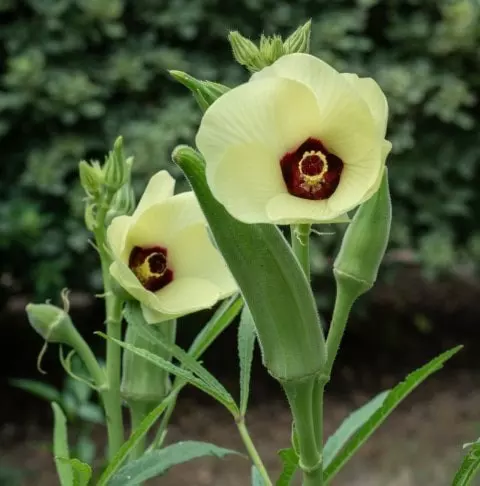
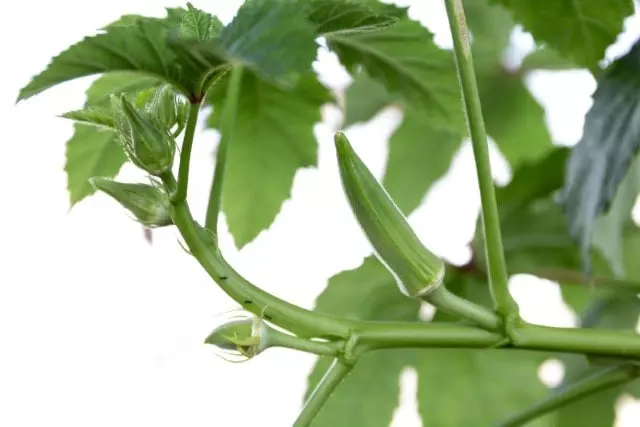
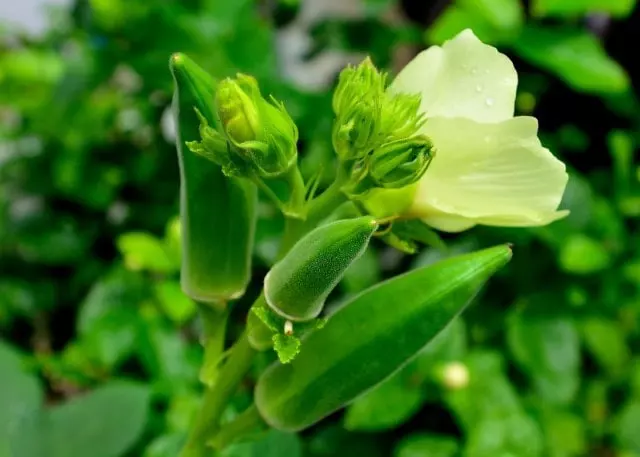
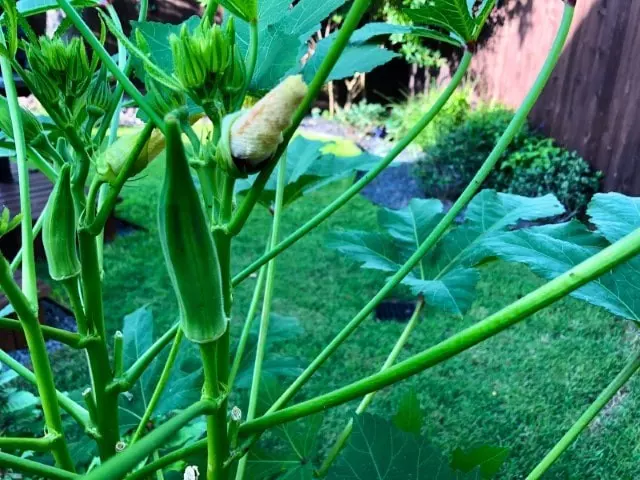
Best Soil to Grow Okra in Containers
The recommended soil for growing okra in containers should be rich in organic matter and potassium. I suggest fertilizing the soil with hummus, which can be hummus prepared at home with earthworms and compost. Maintaining an ideal pH level between 6 and 6.8 further promotes a conducive environment for successful okra cultivation.
How Often to Water Okra in Containers?
Watering okra is all about finding the right balance. Once your okra plants have settled in, they can handle a bit of dryness, but you don’t want to keep them dry for too long. Aim for good, thorough watering each week, especially if there hasn’t been any rain.
For younger plants, make sure to keep their soil consistently moist but not waterlogged—finding that sweet spot in between is the key. Okra plants tend to thrive when they receive around an inch of water per week.
Recommended reading: The BEST Time to Water Plants: Water Wisely!
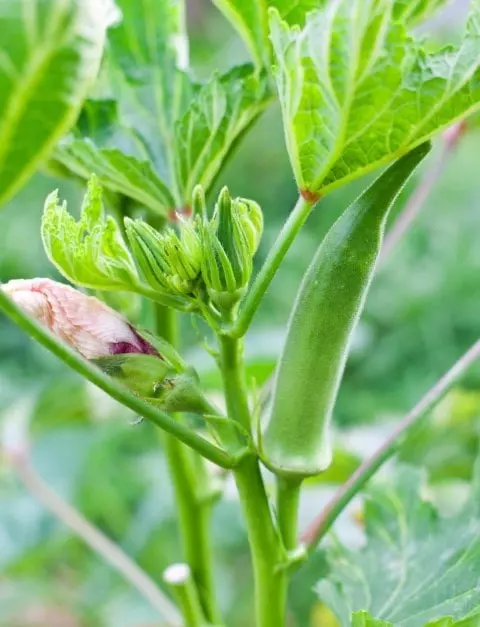
How to Grow Okra in Containers Step by Step
Let’s begin by outlining the steps to plant okra from seeds.
- Choose the Right Container: Select a container that is at least 12-18 inches deep with drainage holes to prevent waterlogging. Opt for a container with a diameter of 18 inches or more to provide ample space for the okra plant to grow.
- Select Quality Soil: Use a well-draining potting mix enriched with organic matter. Ensure the soil pH is around 6.0 to 6.8 for optimal okra growth.
- Planting Okra Seeds: Plant okra seeds about 1 inch deep in the soil. Space the seeds at least 6 inches apart to allow for proper growth.
- Watering: Keep the soil consistently moist but not waterlogged. Water regularly, especially during dry periods, and avoid letting the soil dry out completely.
- Sunlight: Place the container in a sunny location where the okra plant can receive at least 6-8 hours of sunlight per day.
- Support for Growing Okra: Provide support for the okra plants by placing stakes or a trellis in the container. This helps prevent the plants from bending or breaking as they grow.
How to Care Okra Seedlings
If you choose to purchase okra seedlings instead of starting from seeds, here are some tips for caring for okra seedlings in containers:
- Container Selection: Choose a container that provides enough space for the okra seedlings to grow, with proper drainage holes.
- Quality Potting Mix: Use a high-quality potting mix that is well-draining and enriched with organic matter.
- Planting Depth: Ensure the seedlings are planted at the same depth as they were in their original pots.
- Watering: Keep the soil consistently moist, but avoid overwatering to prevent root rot. Water the seedlings regularly, especially during dry spells.
- Sunlight Exposure: Place the container in a sunny location, providing the seedlings with at least 6-8 hours of sunlight per day.
- Fertilization: Apply a balanced, water-soluble fertilizer on the packaging according to the recommended dosage.
- Support for Growing Seedlings: Provide stakes or a small trellis to support the growing seedlings as they mature.
Okra Trellis
Creating a trellis for okra provides support, encourages vertical growth, and makes harvesting easier. Here’s a simple guide on how to set up an okra trellis:
- Materials: Gather sturdy materials such as wooden stakes, bamboo poles, or metal posts. Obtain twine, garden tape, or flexible ties to secure the okra plants to the trellis.
- Placement: Choose a sunny location for the okra trellis, ensuring it receives at least 6-8 hours of sunlight daily. Place the trellis on the northern or eastern side of the okra plants to prevent shading.
- Installation: Drive the stakes or posts into the ground at the ends of the okra row, spaced at least 3 feet apart. Connect horizontal support beams between the stakes, securing them at various heights (around 2-3 feet above the ground). Check out these garden trellis ideas; if you grow okra in a big container, you may want to use one of those.
- Securing Okra Plants: As the okra plants grow, gently tie them to the trellis using twine or flexible ties. Start tying the plants when they reach about 12 inches in height to provide early support.
- Pruning and Training: Encourage bushier growth by pinching off the terminal bud when the plants are around 12 inches tall. Guide lateral branches to grow along the trellis for optimal utilization of vertical space.
- Regular Maintenance: Periodically check the ties to ensure they are not too tight, allowing for natural expansion. Remove any unnecessary lateral branches to maintain a well-organized and supported structure.
Harvesting Okra
When to Harvest Okra?
The optimal time for harvesting okra, especially when you grow okra in containers, falls within a window of 60 to 70 days after the initial sowing. This timeframe accounts for the maturation process from seed to harvest-ready pods.

How do You Know When Okra is Ready to Harvest?
Knowing when to harvest okra is essential for optimal flavor and tenderness. Harvest the pods when they reach a length of approximately 3 to 4 inches, ensuring they are at their most tender and flavorful. Check the texture by gently squeezing the pods; mature okra should feel firm yet slightly pliable, avoiding pods that are too hard. Look for bright green pods, avoiding those that have turned brown, as overripe okra tends to be tough. Regularly monitor your okra plants, harvesting every 2-3 days during the peak growing season.
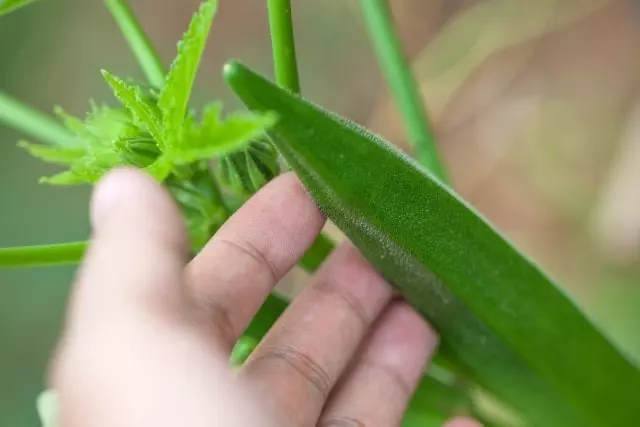
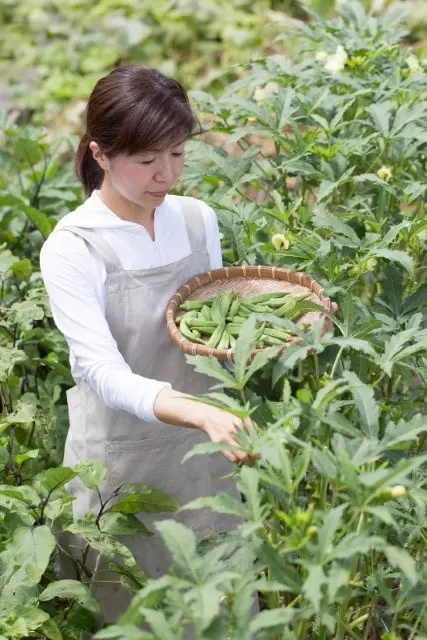
How to Harvest Okra?
To harvest okra, use a clean, sharp knife or scissors or clean pruning shears to cut the pods from the plant when they reach a length of 3 to 4 inches, ensuring tenderness. Harvest regularly every 2-3 days during the peak season, and avoid letting the pods become too large or tough. Hold the pod gently and make a clean cut through the stem, leaving a short piece attached to the pod. Be mindful not to damage the main plant, and collect the harvested okra in a basket or container.
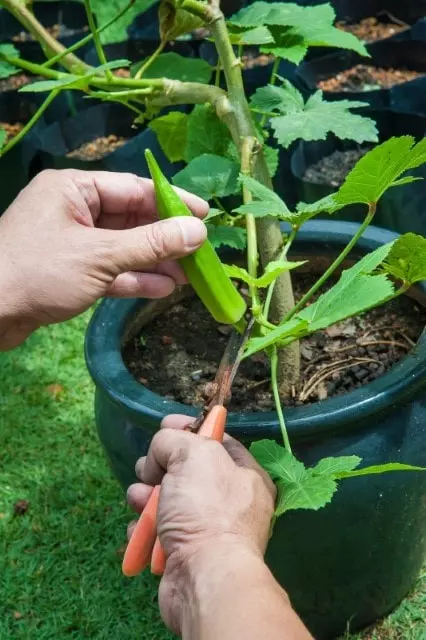
How To Save Okra Seeds for The Next Season
To save okra seeds for the next season, allow a few pods to mature fully on the plant until they turn brown and dry. Once dry, remove the pods, break them open, and collect the seeds. Store the seeds in a cool, dry place in an airtight container until you’re ready to plant them in the upcoming season.
Okra Plant – Diseases and Pests
Okra plants, especially when you grow okra in containers, are susceptible to various diseases and pests that can impact their growth and yield. Here are common issues and how to address them:
Diseases:
Fungal Diseases:
- Symptoms: Yellowing leaves, powdery mildew, or dark spots.
- Prevention/Treatment: Provide adequate spacing for air circulation, avoid overhead watering, and apply fungicides if necessary.
Bacterial Wilt:
- Symptoms: Wilting, yellowing, and sudden plant death.
- Prevention/Treatment: Choose resistant varieties, rotate crops, and remove infected plants promptly.
Root-Knot Nematodes:
- Symptoms: Stunted growth, yellowing, and nodules on roots.
- Prevention/Treatment: Plant resistant varieties, practice crop rotation, and use nematode-resistant rootstocks.
Pests:
Aphids:
- Symptoms: Clusters of small, sap-sucking insects on the undersides of leaves.
- Prevention/Treatment: Use insecticidal soap and neem oil or introduce beneficial insects like ladybugs.
Spider Mites:
- Symptoms: Fine webbing, stippling, and yellowing leaves.
- Prevention/Treatment: Increase humidity, spray plants with water, and use insecticidal soap or neem oil.
Caterpillars (including Bollworms):
- Symptoms: Chewed leaves and damage to pods.
- Prevention/Treatment: Handpick caterpillars, use Bacillus thuringiensis (Bt) insecticide, or introduce natural predators.
Whiteflies:
- Symptoms: Sticky honeydew, yellowing leaves, and sooty mold.
- Prevention/Treatment: Use insecticidal soap and neem oil or introduce natural predators like parasitic wasps.
Japanese Beetles:
- Symptoms: Skeletonized leaves due to feeding.
- Prevention/Treatment: Handpick beetles, use insecticidal soap, or introduce predatory insects.
Recommended reading: Are Ladybugs Good for the Garden?
Okra Leaves Turning Yellow
The leaves of the okra plant may turn yellow when there is a nutrient deficit in the plant. Basically, okra cultivation requires soil with a high organic content that can be quickly regenerated by adding hummus or organic fertilizers.
It is advisable to remove the yellow leaves and fertilize the okra plant, as these yellow leaves will not turn green again. On the other hand, deficit irrigation can cause okra leaves to turn yellow because this plant is not drought-tolerant.
Culinary Uses of Okra
It has a flavor similar to eggplant, is usually consumed cooked, and, to a lesser extent, is added raw in salads or dehydrated.
If you cook it and add lemon, you can use it in numerous stews, as it is perfect to combine with potatoes, eggs, and other vegetables.
Okra has a mucilaginous juice with which the famous Creole okra dish Lousiana is made. If you roast them, it will not give this juice.


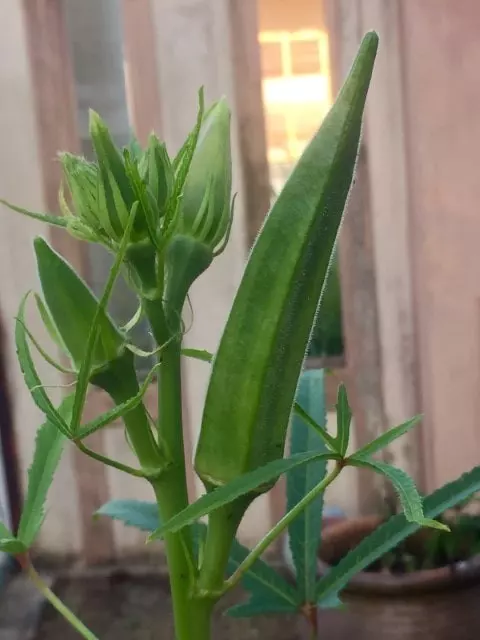
Pin it for later



